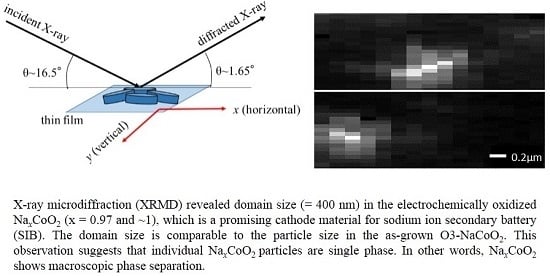Domain Size of Phase-Separated NaxCoO2 as Investigated by X-Ray Microdiffraction
Abstract
:1. Introduction
2. Results
2.1. Discharge Curve of O3-NaCoO Film
2.2. X-Ray Diffraction and Rocking Curve
2.3. X-Ray Microdiffraction
3. Discussion
4. Materials and Methods
4.1. Film Preparation and Characterization
4.2. Control of x
4.3. X-Ray Diffraction and Rocking Curve
4.4. X-Ray Microdiffraction
5. Conclusions
Acknowledgments
Author Contributions
Conflicts of Interest
References
- Kim, S.-W.; Seo, D.-H.; Ma, X.; Ceder, G.; Kang, K. Electrode materials for rechargeable sodium-ion batteries: Potential alternatives to current lithium-ion batteries. Adv. Energy Mater. 2012, 22, 710–721. [Google Scholar] [CrossRef]
- Ong, S.-P.; Chevrier, V.-L.; Hautier, G.; Jain, A.; Moore, C.; Kim, S.; Ma, X.; Ceder, G. Voltage, stability and diffusion barrier differences between sodium-ion and lithium-ion intercalation materials. Energy Environ. Sci. 2011, 4, 3680–3688. [Google Scholar] [CrossRef] [Green Version]
- Komaba, S.; Murata, W.; Ishikawa, T.; Yabuuchi, N.; Ozeki, T.; Nakayama, T.; Ogata, A.; Gotoh, K.; Fujiwara, K. Electrochemical Na insertion and solid electrolyte interphase for hard-carbon electrodes and application to Na-ion batteries. Adv. Energy Mater. 2011, 21, 3859–3867. [Google Scholar] [CrossRef]
- Komaba, S.; Takei, C.; Nakayama, T.; Ogata, A.; Yabuuchi, N. Electrochemical intercalation activity of layered NaCrO2 vs. LiCrO2. Electrochem. Commun. 2010, 12, 355–358. [Google Scholar] [CrossRef]
- Yoshida, H.; Yabuuchi, N.; Komaba, S. NaFe0.5Co0.5O2 as high energy and power positive electrode for Na-ion batteries. Electrochem. Commun. 2013, 34, 60–63. [Google Scholar] [CrossRef]
- Zhao, K.; Zhao, L.; Dimov, N.; Okada, S.; Nishida, T. Electrochemical and thermal properties of α-NaFeO2 cathode for Na-ion batteries. J. Electrochem. Soc. 2013, 160, A3077–A3081. [Google Scholar] [CrossRef]
- Lei, Y.; Li, X.; Liu, L.; Ceder, G. Synthesis and stoichiometry of different layered sodium cobalt oxides. Chem. Mater. 2014, 26, 5288–5296. [Google Scholar] [CrossRef]
- Delmas, C.; Braconnier, J.; Fouassier, C.; Hagenmuller, P. Electrochemical intercalation of sodium in NaxCoO2 bronzes. Solid State Ion. 1981, 3–4, 165–169. [Google Scholar] [CrossRef]
- Shibata, T.; Fukuzumi, Y.; Kaboyashi, W.; Moritomo, Y. Fast discharge process of layered cobalt oxides due to high Na+ diffusion. Sci. Rep. 2015, 5. [Google Scholar] [CrossRef] [PubMed]
- Delmas, C.; Maccario, M.; Croguennec, L.; Le Cras, F.; Weill, F. Lithium deintercalation in LiFePO4 nanoparticles via a domino-cascade model. Nat. Mater. 2008, 7, 665–671. [Google Scholar] [CrossRef] [PubMed]
- Imai, Y.; Kimura, S.; Sakata, O.; Sakai, A. High-angular-resolution microbeam X-ray diffraction with CCD detector. AIP Conf. Proc. 2010, 1221, 30–32. [Google Scholar]
- Takeda, S.; Kimura, S.; Skata, O.; Sakai, A. Development of high-angular-resolution microdiffraction system for reciprocal space map measurement. Jpn. J. Appl. Phys. 2006, 45, L1054–L1056. [Google Scholar] [CrossRef]
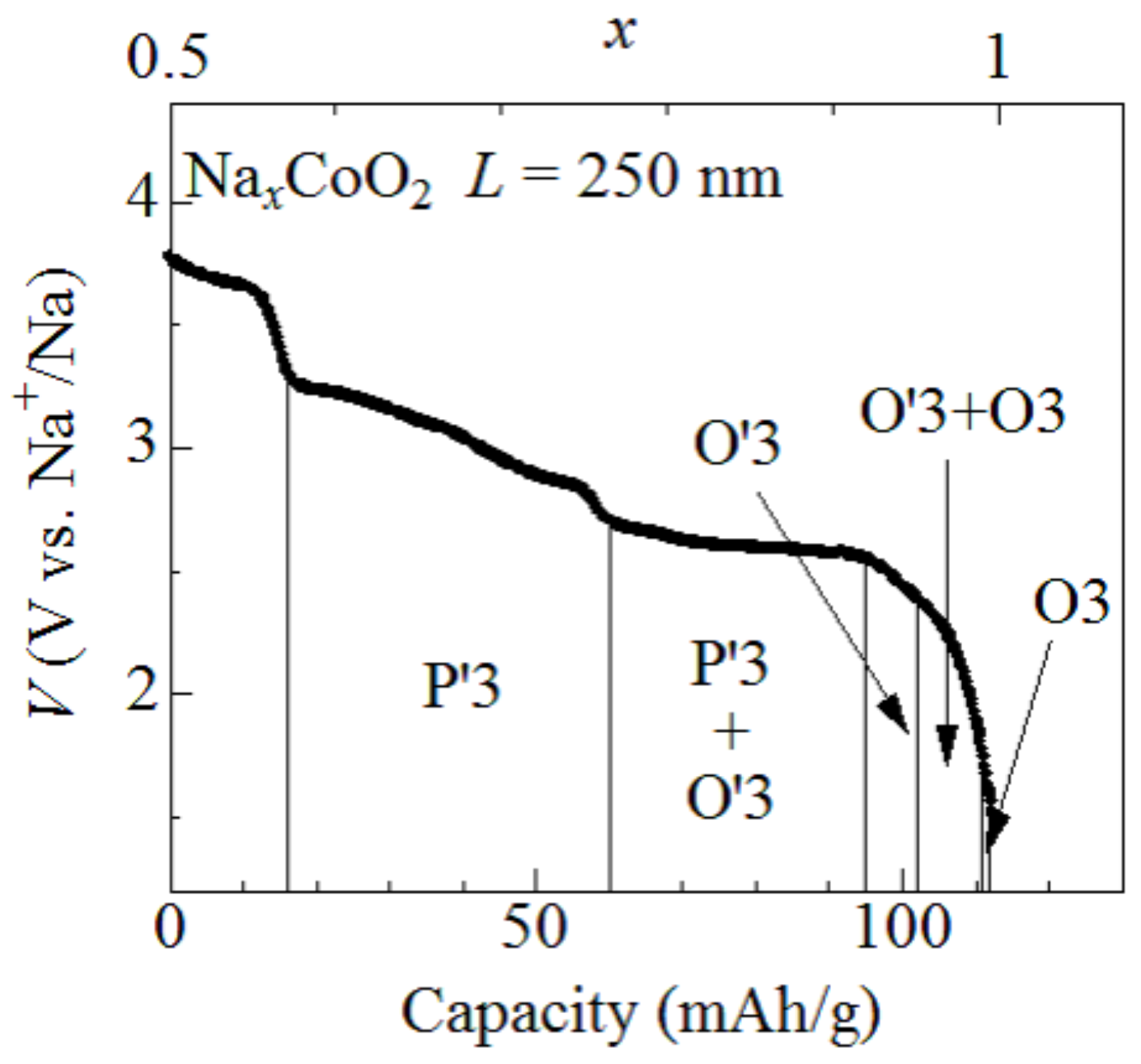
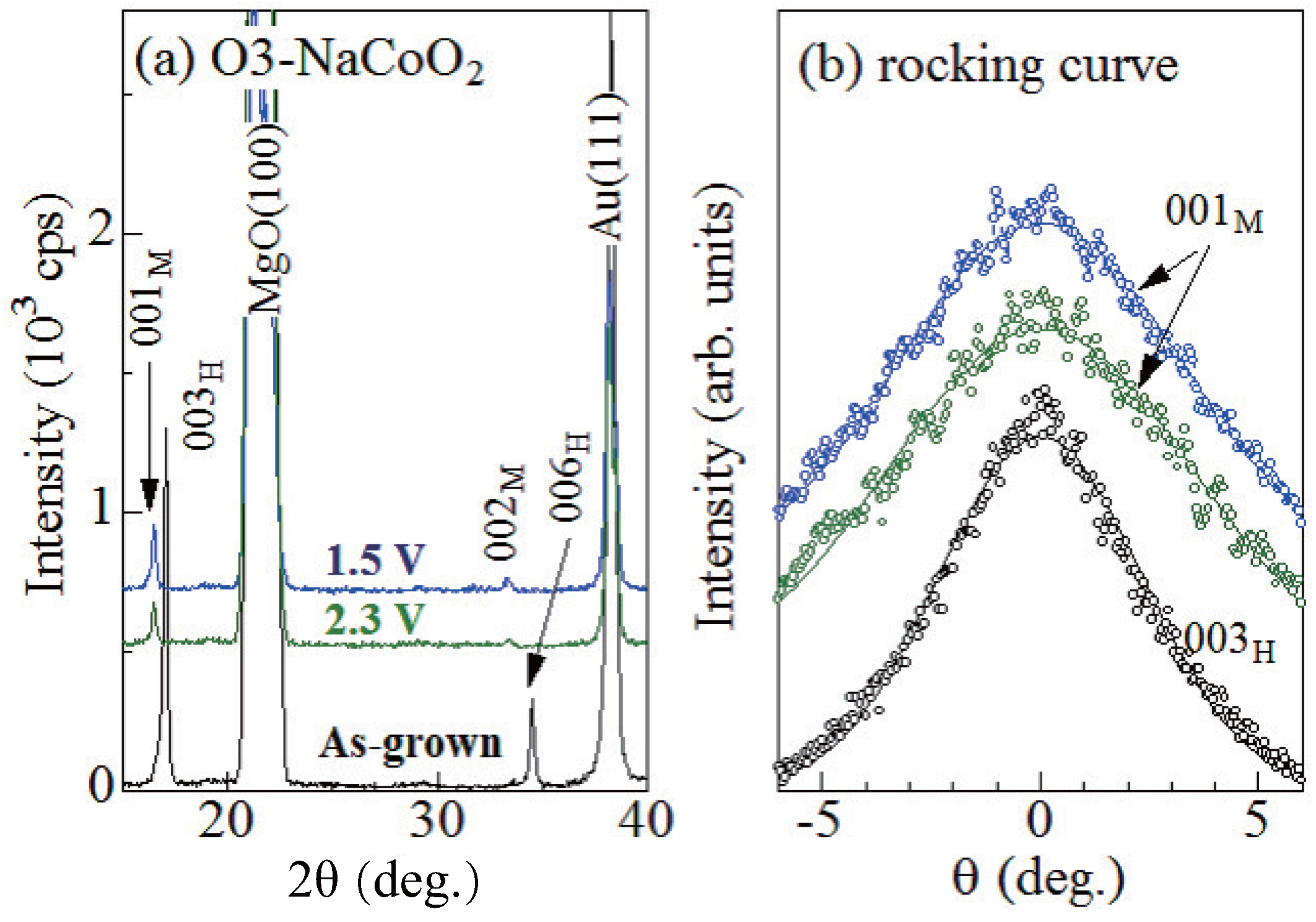
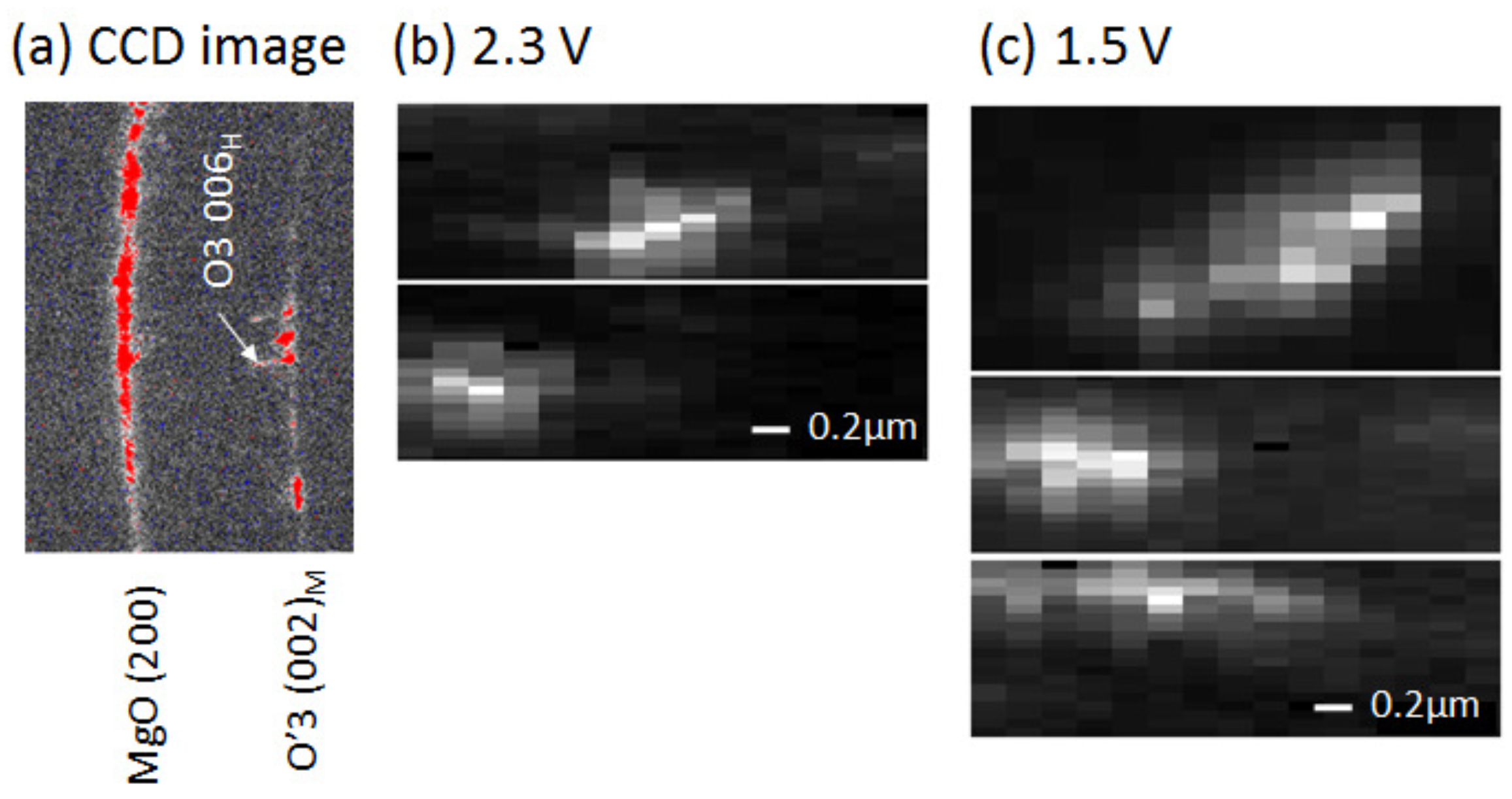
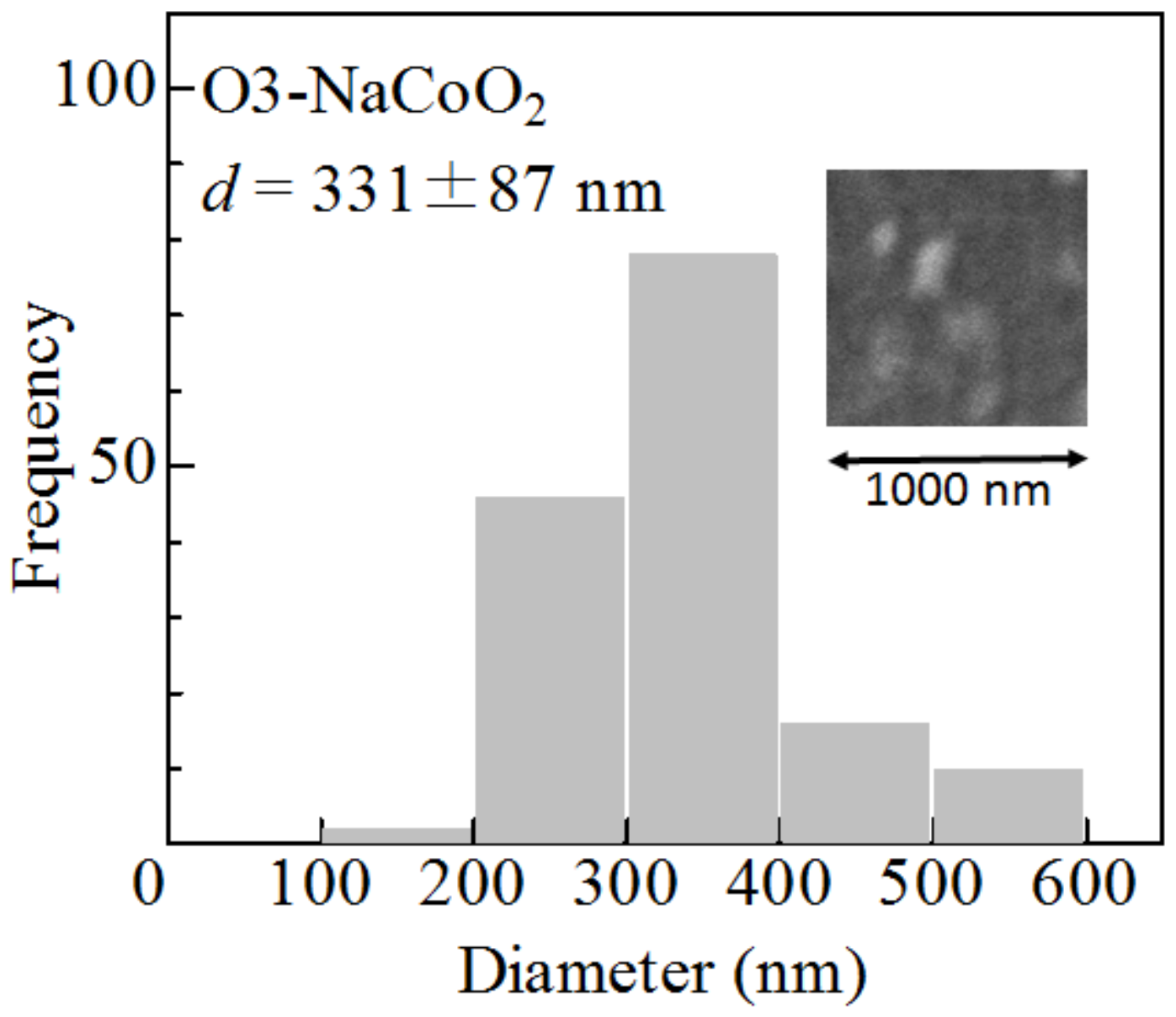

© 2017 by the authors. Licensee MDPI, Basel, Switzerland. This article is an open access article distributed under the terms and conditions of the Creative Commons Attribution (CC BY) license ( http://creativecommons.org/licenses/by/4.0/).
Share and Cite
Niwa, H.; Shibata, T.; Imai, Y.; Kimura, S.; Moritomo, Y. Domain Size of Phase-Separated NaxCoO2 as Investigated by X-Ray Microdiffraction. Batteries 2017, 3, 5. https://doi.org/10.3390/batteries3010005
Niwa H, Shibata T, Imai Y, Kimura S, Moritomo Y. Domain Size of Phase-Separated NaxCoO2 as Investigated by X-Ray Microdiffraction. Batteries. 2017; 3(1):5. https://doi.org/10.3390/batteries3010005
Chicago/Turabian StyleNiwa, Hideharu, Takayuki Shibata, Yasuhiko Imai, Shigeru Kimura, and Yutaka Moritomo. 2017. "Domain Size of Phase-Separated NaxCoO2 as Investigated by X-Ray Microdiffraction" Batteries 3, no. 1: 5. https://doi.org/10.3390/batteries3010005




